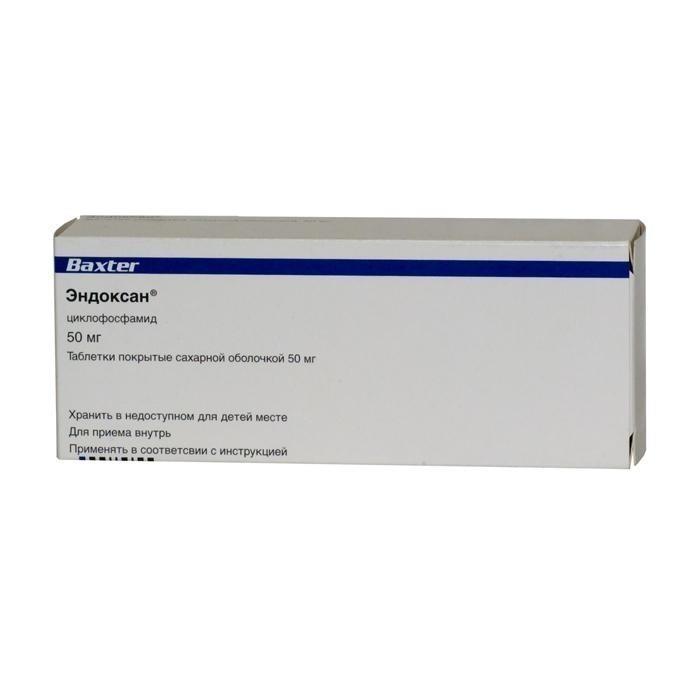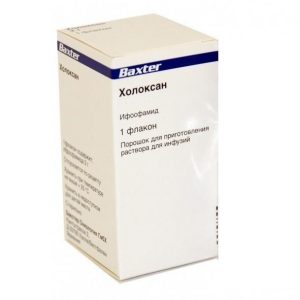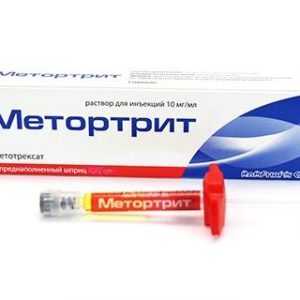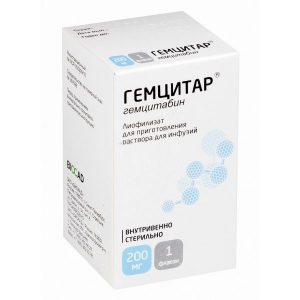Description
Latin name
ENDOXAN
Release form
Sugar-coated tablets.
Packing
In a blister pack of 10 tablets. In cardboard packaging 5, 40, 100 or 200 blisters.
Pharmacological action
Pharmacodynamics
Antitumor agent alkylating action. It has a cytostatic and immunosuppressive effect. The antitumor effect is realized directly in the tumor cells, where cyclophosphamide is biotransformed under the action of phosphatases with the formation of an active metabolite with an alkylating effect.
Pharmacokinetics
After a single intravenous administration, the concentration of cyclophosphamide and its metabolites in plasma rapidly decreases in the first 24 hours, but can be determined within 72 hours. When administered orally, the concentrations of cyclophosphamide and its metabolites are almost the same as with iv .
T1 / 2 from plasma after intravenous administration averages 7 hours in adults and about 4 hours in children. It is excreted in urine and bile.
ovarian cancer, breast cancer, lung cancer
Hodgkin lymphoma, non-Hodgkin’s lymphosarcoma
reticulosarcoma
osteosarcoma
multiple myeloma, chronic lymphocytic leukemia, acute lymphoblastic leukemia
Wilms tumor
Ewing sarcoma
testicular seminoma.
prevention of transplant rejection reaction.
rheumatoid arthritis, multiple sclerosis, systemic lupus erythematosus, nephrotic syndrome (as an immunosuppressant).
Contraindications
Cachexia
anemia
leukopenia
thrombocytopenia
heart failure
severe liver and / or kidney disease
pregnancy.
Use during pregnancy and lactation
Cyclophosphamide is contraindicated in pregnancy. If necessary, use during lactation should decide on the termination of breastfeeding.
Women of childbearing age should use reliable methods of contraception during therapy.
In experimental studies, the teratogenic and embryotoxic effects of cyclophosphamide have been established.
Composition
1 tablet contains:
Active substances: cyclophosphamide 50 mg.
Dosage and administration of
Set individually, depending on the indications and stage of the disease, the state of the hematopoietic system, anti-tumor therapy regimen.
Side effects
From the digestive system: nausea, vomiting, diarrhea, stomach pain rarely – toxic hepatitis.
From the hemopoietic system: leukopenia, thrombocytopenia, anemia.
From the respiratory system: with prolonged use of high doses – pneumonitis or interstitial pulmonary fibrosis.
From the cardiovascular system: tachycardia, shortness of breath, acute myopericarditis in some cases – severe heart failure (associated with hemorrhagic myocarditis and myocardial necrosis).
From the urinary system: aseptic hemorrhagic cystitis, nephropathy (associated with hyperuricemia).
From the reproductive system: menstrual irregularities, amenorrhea, azoospermia.
Allergic reactions: skin rash, urticaria, anaphylactic reactions.
Other: alopecia, muscle and bone pain, headache.
Drug Interaction
When used with cyclophosphamide, it may potentiate hypoglycemic agents.
Combined use with allopurinol may increase myelotoxicity.
When used with indirect anticoagulants, anticoagulant activity may change (as a rule, cyclophosphamide reduces the synthesis of coagulation factors in the liver and disrupts platelet formation).
When combined with cytarabine, daunorubicin or doxorubicin, cardiotoxicity may be increased.
When combined with immunosuppressants, the risk of infection and secondary tumors is increased.
The combined use of cyclophosphamide with lovastatin increases the risk of acute skeletal muscle necrosis and acute renal failure.
Medicines, which are inducers of microsomal enzymes, cause increased formation of active metabolites of cyclophosphamide, which leads to an increase in its action.
Overdose
Treatment: Use supportive measures, including appropriate treatment for infections, manifestations of myelosuppression and / or cardiotoxicity. There is no specific antidote. Treatment is symptomatic.
Storage conditions
Store at a temperature not exceeding 25 ° C.
Expiration
3 years.
Deystvuyuschee substances
tsiklofosfamida
Dosage form
Dosage form
tablets




